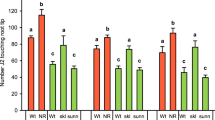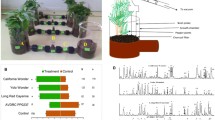Abstract
Simple inorganic salts of the ions K+, NH +4 , Cs+, NO −3 , and Cl− are strongly repellent to infective second-stage larvae of the root knot nematode,Meloidogyne incognita. Some of these salts are known to be beneficial to plant growth. The results suggest a new means of plant protection.
Similar content being viewed by others
References
Castro, C.E., Belser, N.O., McKinney, H.E., andThomason, I.J. 1989. A quantitative bioassay for chemotaxis with plant parasitic nematodes. Attractant and repellent fractions forMeloidogyne incognita from cucumber roots.J. Chem. Ecol. 15:1297–1309.
Chow, T.J., andJohnstone, M.S. 1962. Determination of nitrate in sea water.Anal. Chim. Acta 27:441–446.
Cotton, F.A., andWilkinson, G. 1988. Advanced Inorganic Chemistry. John Wiley & Sons, New York. Chapter 4, pp. 123–125.
Dusenbery, D.B. 1987. Prospects for exploiting sensory stimuli in nematode control, pp. 131–135,in J.A. Veech and D.W. Dickson (eds.). Vistas in Nematology. Society of Nematology, Hyattsville, Maryland.
Garcia Basalotte, M., Lopez Alcala, J.M., Puerta Vizcaino, M.C., andGonzalez Vilclaez, F. 1986. Dinitrogen complexes of iron(II) with (1,2-ethanediyldinitrilo)tetraacetate and trans-(1,2-cyclohexanediyldinitrilo)tetraacetate.Inorg. Synth. 24:207–208.
Prot, J.C. 1978a. Influence of concentration gradients of salts on the movement of second stage juveniles ofMeloidogyne javanica.Rev. Nematol. 1:21–26.
Prot, J.C. 1978b. Behaviour of juveniles ofMeloidogyne javanica in salt gradients.Rev. Nematol. 1:135–142.
Prot, J.C. 1979a. Influence of concentration gradients of salts on the behaviour of four plant parasitic nematodes.Rev. Nematol. 2:11–16.
Prot, J.C. 1979b. Horizontal migrations of second stage juveniles ofMeloidogyne javanica in sand in concentration gradients of salts and in a moisture gradient.Rev. Nematol. 2:17–21.
Riddle, D.L., andBird, A.F. 1985. Responses of the plant parasitic nematodesRotylenchulus reniformis, Anguina agrostis andMeloidogyne javanica to chemical attractants.J. Nematol 91:185–195.
Steiner, G. 1925. The problem of host selection and host specialization of certain plant-infesting nemas and its application in the study of nemic pests.Phytopathology 15:499–534.
Ward, S. 1973. Chemotaxis by the nematodeCaenorhabditis elegans: Identification of attractants and analysis of the response by use of mutants.Proc. Natl. Acad. Sci. U.S.A. 70:817–821.
Author information
Authors and Affiliations
Rights and permissions
About this article
Cite this article
Castro, C.E., Belser, N.O., McKinney, H.E. et al. Strong repellency of the root knot nematode,Meloidogyne incognita by specific inorganic ions. J Chem Ecol 16, 1199–1205 (1990). https://doi.org/10.1007/BF01021019
Received:
Accepted:
Issue Date:
DOI: https://doi.org/10.1007/BF01021019




